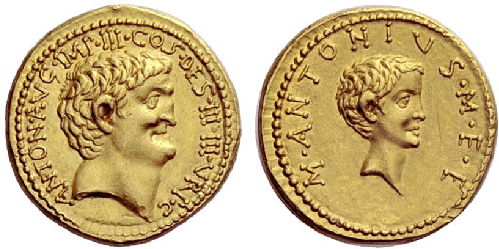All entries for Thursday 13 February 2014
February 13, 2014
Succession and the Aurei of Mark Antony
 |
| Aureus showing Antony and his son Antyllus |
The problem of succession, and Augustus' means of communicating succession, form a key theme in the study of the Augustan principate. But the mechanisms for communicating succession and dynasty in the principate arose directly out of the Republic, in particular the strategies employed during the civil wars. We can see this in a gold aureus series struck for Mark Antony in 34 BC while he was triumvir in the East (RRC 541/1-2). The design of this series foreshadows how imperial dynasty and succession would later be communicated during the Roman Empire.
The coin issue consisted of two different types, but both of them carried the portrait of Mark Antony on the obverse and the portrait of his eldest son Marcus Antonius Antyllus on the reverse. Antyllus was the child of Antony and Fulvia, and was at one point engaged to Octavian's daughter Julia. His appearance on coinage here suggests that Antony may have been attempting to establish and advertise a successor, well before Augustus would later turn to the problem.
This is also suggested by the legends of these pieces. On the first type, the titles of Antony occupy both the obverse and reverse of the coin (M ANTONI M F M N AVG IMP TERT, COS ITER DESIG TERT III VIR R P C, Marcus Antonius, son of Marcus, grandson of Marcus, Augur, Imperator for the third time, consul for the second time, consul designate for the third time, triumvir for the establishment of the Republic). That Antony included the names of his father and grandfather must have been intentional: in contrast to Octavian's claims to be the son of the divine Caesar, Antony represents his descent in a traditional Roman manner, something which may have appealed to the Senate rather more than Octavian's claims. One the second type of this issue (shown above), Antony's titles are abbreviated and confined to the obverse of the coin, while the reverse carries the name of Marcus Antonius Antyllus, who is presented as the son of Antony (M ANTONIVS M F F). Thus over both types, Antony and his positions are communicated, as is Antony's ancestry and his successor, a presentation that is remarkably similar to what would occur later in the imperial period.
Coin image reproduced courtesy of Numismatica Ars Classica NAC AG (Auction 54, Lot 285)
 Clare Rowan
Clare Rowan

 Please wait - comments are loading
Please wait - comments are loading

 Loading…
Loading…